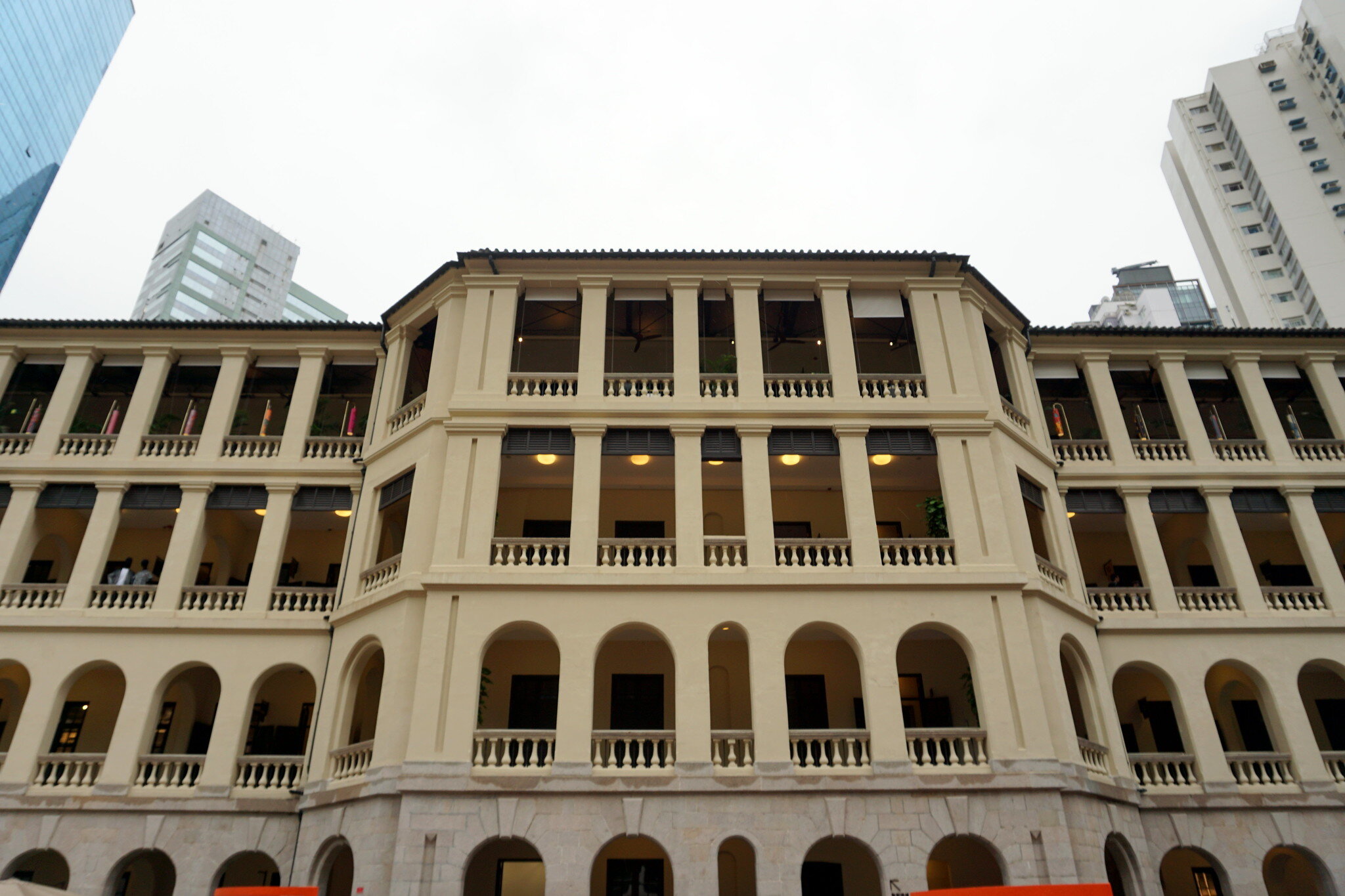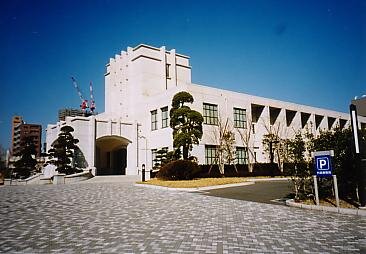Tanba Mangan Kinenkan
Emergence of Contestation: 1989
The Tanba Mangan Kinenkan is a small private museum near Kyoto which houses information on the conscription of Korean labourers in the early twentieth century
Museum Education through Reenactment: Considering Historical Sites in Korea and Japan - Jason Mark Alexander
Tai Kwun Centre for Heritage and Arts, Hong Kong
Emergence of Contestation: 2018
Tai Kwun police station was redeveloped and opened to the public in 2018, and comprises three former surveillance apparati: the central police station, the central magistracy and Victoria Prison. At first, in the courtyard of the beautifully renovated compound, one sees mostly the American bars and French restaurants, with spaces for shops selling all kinds of crafts and design materials, and, in the upper part of the complex, a gallery for contemporary art. In the buildings, there are a number of signposted notices pertaining to the history of place, as well as a visitor centre that guides you into the overall history of the buildings. History is thus here not hidden but clearly labelled, but judgement on its status remains cautious.
Art in Former Military Sites: Spectres of Geopolitics in Southeast Asia - Gabriel Gee
Qijin Kitchen, Kaohsiung
Qijin kitchen is a project developed by the Taiwanese artist Wu Mali in Kaohsiung, the main harbour city in the south of Taiwan. The kitchen is located on Qijin island, a thin band of land that separates the inner bay of Kaohsiung from the ocean. The history of Kaohsiung harbour is tied to the island’s position at the top of the Southern China seas. Qijin island has been for many centuries populated by fishermen, and today is made to stand for a ‘vernacular Taiwan’, a glimpse into the pre-industrialized world. This is a false impression, as the population, in the past as today, is made up of migrants sailing the waves of history, and consuming foodstuffs from well beyond Taiwan's current borders.
Art in Former Military Sites: Spectres of Geopolitics in Southeast Asia - Gabriel Gee
Puppet Emperor Palace Museum
Emergence of Contestation: 1984
The Puppet Emperor Palace, dedicated to China's emperor Puyi, is at present designed to serve as a "site of memory" for the emperor's life journey from the throne to becoming an ordinary citizen of the newly formed Chinese state, as well as a symbol of China's successfull wartime struggle against the Japanese rule (specifically Japan's puppet government in Manchukuo). However, the site itself did not serve as the stage for most of Puyi's conversion, nor did it figure prominently in the Chinese resistance, which seemingly somewhat undermines its claim to the "site of memory" title. A consideration of the actual history of active Japanese governance associated with the site (as opposed to the "victim narrative" carefully constructed by the CCP) could restore this title to the museum, but would require a departure from the official Party narrative aimed at centering national legitimacy.
Beyond a "Site of Memory": The Puppet Emperor Palace Museum - Emily Matson
National Memorial Museum
Emergence of Contestation: 2014
The National Memorial Museum of Korea in Pusan focuses on the Japanese conscription of Korean labourers during the period of colonial expansion, focussing particularly on the lived experiences of the colonized.
Museum Education through Reenactment: Considering Historical Sites in Korea and Japan - Jason Mark Alexander
https://www.flickr.com/photos/kiyong2/49037497296/
Kinmen Islands
Emergence of Contestation: 2013
In 2004, the contemporary art and heritage programme was devised for Kinmen Island, just off the coast of China. The island was a territorial bastion of the Republic of China, and was covered in bunkers and other paraphenalia associated with Cold War front lines, to the extent that it has been christened as 'Taiwan's DMZ' (LINK). After China's opening and reform, and the relative appeasement over the straits that marked the turn to the 21st century, the site was identified as a significant space in which to engage with dark memories and heritage, and consider an alternate construction of the future.
Art in Former Military Sites: Spectres of Geopolitics in Southeast Asia - Gabriel Gee; J.J Zhang
June 4th Museum (Tiananmen Incident)
Emergence of Contestation: 2019
The June 4th Museum in Hong Kong commemorates the student democratization movement and the Tiananmen Incident in 1989 in Beijing. There has been several instances that the museum was broken into by the unknown forces and protested against by the pro-Beijing groups in Hong Kong, who claimed that the museum is distorting history. In mainland China the Tiananmen Incident is identified as student riot, which is counter-revolutionary, whereas elsewhere the Incident is widely seen as democratization movement that was repressed by the authorities.
Centre for Contemporary Arts, Singapore
Emergence of Contestation: 1960s
The Centre for Contemporary Art in Singapore opened in 2013 in a series of white buildings, neatly spaced out in a green environment near the Pasir Panjang district. While the seeming archetype of a white cube neutral settings, the cluster of white buildings were originally the Gillman Barracks, erected in 1936 as part of a large military zone complete with schools, hospital facilities and residential housing. They were handed over to the Singaporean State following its declaration of independence in 1965, before being repurposed into an aesthetic abstraction bordering on the decorative.
Art in Former Military Sites: Spectres of Geopolitics in Southeast Asia - Gabriel Gee
Ahn Martyr Memorial Museum 【安重根(An Chung-gun)】
Emergence of Contestation: 2014
The South Korean President Park visited China in 2013, and expressed the idea of building a museum to commemorate An Chung-gun in Harbin, the city where he assassinated Ito Hirobumi. After the construction of the museum in 2014, it was protested against by the Japanese Foreign Minister (2014, Jan. 20). Though An is widely remembered as an Anti-Japanese patriot in China and South Korea, he was regarded as a terrorist in Japan.
Ichigaya Memorial Hall
Emergence of Contestation: 1946, 1990s
The courtroom at the Ichigaya site where the International Military Tribunal for the Far East was held has been preserved through a collaborative effort of conservative and progressive activists. The site was supposedly to commemorate either the Japanese wartime crimes, or the allies' victor's justice over the defeated Japanese leaders. When contrasted with the site of the Nuremberg Trials, however, the site draws little attention to the war trials themselves. Moreover, the items exhibited at Ichigaya make a bias in favour of the "victor's justice" narrative apparent.
Competing Memories of Victor's Justice vs Aggressive Warfare at Ichigaya Memorial - André Hertrich
Ainu Remains
Emergence of Contestation: 1869
The Ainu human remains stolen from Hokkaido gravesites for scientific purposes in the period of the Japanese colonisation of Hokkaido are presently still housed in museum collections across the globe, provoking protest from Ainu activists who demand their return. The remains themselves have become sites of memory through which Japanese colonial amnesia is challenged.
Stolen Ainu Remains as Sites of Memory - Michael Roellinghoff
War Memorial of Korea
Emergence of Contestation - 1994
The War Memorial in Seoul commemorates the successful military campaigns of Korea, and aims at preventing future wars through education. However, the museum has been criticised as a glorification of Korea's military past, as it fails to offer any counter-narratives and does not highlight wartime atrocities perpetrated by Korean soldiers in Vietnam, as well as as domestically during the suppression of the democratic protests of 1980.
War Memorial of Korea - Dasom Lee






















